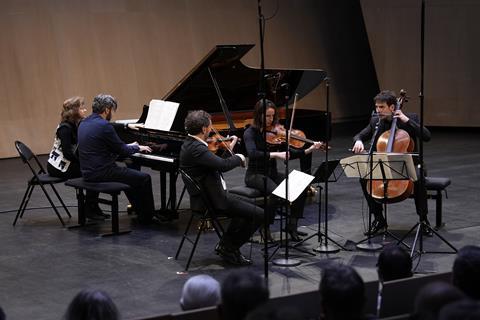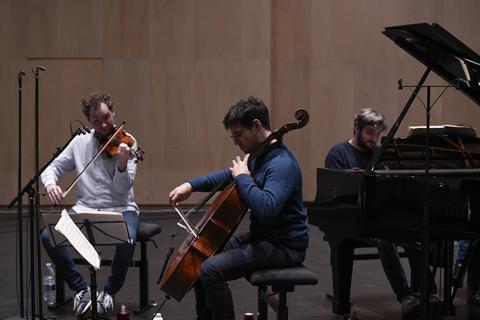Ahead of the release of a third volume of Robert Schumman’s chamber works, violinist and pianist Pierre and Théo Fouchenneret explore the pieces’ history, as well as the influence of Clara Schumann and Felix Mendelssohn

Discover more Featured Stories like this in The Strad Playing Hub
Two shadows soar over the Third Volume of this Schumann Collection – that of Robert’s wife, Clara Schumann, virtuoso pianist and composer, and that of Felix Mendelssohn. As a child prodigy, pianist and composer gifted with outstanding abilities, Mendelssohn took over important responsibilities at a young age at the head of the Gewandhaus in Leipzig. There, he included Robert’s works on the programme more than once.
Schumann was only one year younger than Mendelssohn but was struggling to achieve recognition of his music. In return, Robert tried to recruit his friend at the music journal he had just founded, Neue Zeitschrift für Musik. The Schumanns and Mendelssohn met up regularly to play billiards and chess, or read scores, as well as sharing their admiration for the works of Beethoven and Bach, thus developing a deep friendship. So, it was not a surprise when Clara and Robert made Felix godfather to their first daughter, Marie, born in September, 1841.
This bond shines through the works of the following year, which is commonly nicknamed ’the chamber music year’ for Robert who, now a young father, focused on family-sized line-ups. Hence, he wrote three String Quartets, Opus 41, dedicated to Mendelssohn, a Piano and String Quintet, Opus 44, and a Piano and String Quartet, Opus 47, which Felix would play for the first time on the piano – even before Clara herself – at a private performance on Saint Nicolas Day, 6 December, 1842.
This latter work, in particular, has the hallmark of Mendelssohn’s influence on Robert. For example, we hear the Lutherian chorale Wer nun den lieben Gott lässt walten (’He who only lets dear God rule… shall be sustained wondrously in all torment and sorrow’) surface in its first movement. This had been adapted into a cantata by Felix a few years earlier whilst the finale opens to a fugue reminiscent of the fondness the two composers had for Bach’s art. However, the second and third movements are the ones which bear a Mendelssohnian stamp still more noticeably. The scherzo is a spiritual piece of music with enchanting staccato in the characteristic style of that composer of A Midsummer Night’s Dream, and the moving Andante cantabile sets forth a veritable Lied without lyrics which is worthy of Felix. Nevertheless, this musical kinship between the two friends must not outshine the strong personality of a well and truly Schumannian work. The density of the counterpoint, the keen vigour of the chiaroscuro, and the rhythmic intensity of the motifs make this Quartet, Opus 47 into one of the great works composed by Robert Schumann in 1842.
On the day the work was first performed by Mendelssohn, a note in Schumann’s diary shows that the chamber music year was to be continued: Robert wrote down starkly, ’Triogedanken’ (trio ideas), and set to work immediately, starting to explore the trio repertoire for piano and strings. However, it would take a number of years before harvesting the fruits of this labour. The initial drafts became Phantasiestücke (Fantasy Pieces), Opus 88, which would not be published in their definitive version until 1850.

In the meantime, Schumann created his first true Trio for Piano and Strings in D minor, Opus 63 in 1847. One cannot help but be reminded of Mendelssohn once again, who also had composed a Trio in D minor for which Schumann had unbridled admiration. He wrote the following in 1840, ’It is the master trio of our time, as were those of Beethoven in B flat and D, and that of Franz Schubert in E flat in their time.’
The tormented beginning of the Schumannian Trio is very similar to its Mendelssohnian counterpart, which brings both works closer together, and the context might push them closer still. It is troubling to think that Schumann set about composing his Trio in D minor (a traditionally funereal key) shortly after the death of Fanny Mendelssohn, Felix’s beloved sister, and herself composer of a Trio in D minor not long before her passing.
Schumann’s diary, however, suggests that Robert was not so focused on Mendelssohn at the time as on Clara, who, one year earlier, had given her husband a Trio for Piano and Strings in G minor, Opus 17, for their seventh wedding anniversary. In a game of compositional ping-pong, of which the couple were particularly fond, Robert reciprocated by presenting his wife with his completed Trio, Opus 63, for her 28th birthday on the 13 September, 1847. He was especially pleased with his work and did not want to stop there, tackling at once a Trio in F major, Opus 80, which was even more ’Clara-esque’ than the previous one. Its first movement uses one of his Lieder which is the most loving towards his wife, ’Intermezzo,’ extracted from the Liederkreis, Opus 39 song cycle: ’My heart sings silently to itself / A lovely old song / Which soars into the air / And hastens to you.’
As for Mit innigem Ausdruck (“With tender expression”), which serves as the second movement, the way in which the violin and cello’s melody lines are interwoven in opposite motion is sensuously eloquent. Far from the frenzied Mendelssohnian scherzos, the third movement prolongs the feeling of tenderness which unites the instruments. Set to a quivering, moderately danceable rhythmic motif, the three parts imitate and reply to one another on the same wavelength. Suddenly adopting a binary rhythm, the remarkable ending is not any the less gentle with Robert slipping in a hint of his Frauen-Liebe und Leben (A Woman’s Love and Life) cycle. One can hear an allusion to the cycle as well as to ’Intermezzo’ from Liederkreis in the finale… And it is not a surprise that Clara was particularly enthusiastic about this Trio, Opus 80!
The Trio in G minor, Opus 110, which alludes to Clara once again, was conceived much later in 1851 in Düsseldorf, where the composer had just taken on important duties. The key is the same as for Trio, Opus 17, by Clara and the amazing fugue-like section in the first movement might be seen as a subtle reflection of the finale in that same work. However, more than anything, we find in this last Trio, Robert’s ‘voice’ – or rather voices displaying all his own personality: His arpeggiated outbursts akin to ’The Prophet-Bird’ are worthy of Waldszenen (Forest Scenes) Opus 82 (first movement); his convoluted meanderings (third movement); and the way in which he goes from a tormented post-Schubertian song (second movement) to a joyful folk skit filled with rhythmic-melodic ‘characters’ (the rustic finale), within a few pages of music are all typical of Schumannian artistry.
Robert’s personality can be felt right from the First Trio, Opus 63, in which for the first time outside pure piano repertoire, the composer decided to free himself from the traditional Italian musical terms used for movements to adopt German terms which were far richer in the poetic sense. Thus, the third movement is already the place for an extremely expressive inner voice (Langsam, mit inniger Empfindung – ’Slowly, with inner feeling’) before the formidable bubbling of the finale Mit Feuer (‘With fire’), in a contrast characteristic of Schumann. From the very first movement of this Trio, Opus 63, the composer veers off the beaten track into a realm which belongs to him alone. In the middle of that piece of music indicated as Mit Energie und Leidenschaft (’With energy and passion’), we have the piano, which has been made tinkly-sounding by using the soft pedal, launch into a supernatural chorale in its high-pitched register. Angels’ voices? Devilish apparitions? Being a highly unusual thing to do in that era, bowed string instruments scrapingly venture onto their bridges, accompanying the chorale into another world, far from Felix, far from Clara, far from everything.
The Third Volume of the Schumann Collection featuring the complete Trios for piano and strings and Quartet for piano and strings op.47 will be released on 12 April 2024 on b.records. The album features violinist Pierre Fouchenneret, violist Lise Berthaud, cellist Victor Julien-Laferrière and pianist Théo Fouchenneret.
Read: Cristian Grajner de Sá on works by Amy Beach, Ethel Smyth and Clara Schumann
Read: ‘Music so sublime it reaches heaven’: Gary Hoffman on the Schumann Cello Concerto
Read more Featured Stories like this in The Strad Playing Hub
The number one source for playing and teaching books, guides, CDs, calendars and back issues of the magazine.
In The Best of Technique you’ll discover the top playing tips of the world’s leading string players and teachers. It’s packed full of exercises for students, plus examples from the standard repertoire to show you how to integrate the technique into your playing.
The Strad’s Masterclass series brings together the finest string players with some of the greatest string works ever written. Always one of our most popular sections, Masterclass has been an invaluable aid to aspiring soloists, chamber musicians and string teachers since the 1990s.
American collector David L. Fulton amassed one of the 20th century’s finest collections of stringed instruments. This year’s calendar pays tribute to some of these priceless treasures, including Yehudi Menuhin’s celebrated ‘Lord Wilton’ Guarneri, the Carlo Bergonzi once played by Fritz Kreisler, and four instruments by Antonio Stradivari.













































No comments yet